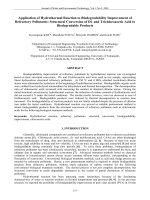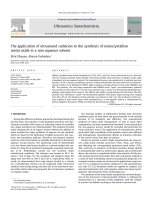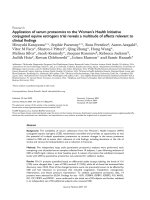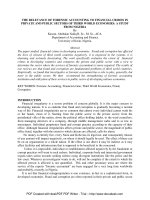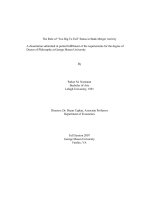Application of the theory of planned behavior to ethical dilemmas in organizations
Bạn đang xem bản rút gọn của tài liệu. Xem và tải ngay bản đầy đủ của tài liệu tại đây (877.64 KB, 141 trang )
Name:
Chia Nah Nah
Degree:
M.SC. (MGT.)
Department:
Management and Organization
Thesis title:
Application of the theory of planned
behavior to ethical dilemmas in organizations
Year of submission:
2003
I
APPLICATION OF THE THEORY OF PLANNED
BEHAVIOR TO ETHICAL DILEMMAS
IN ORGANIZATIONS
CHIA NAH NAH
B.B.A. (HONS), NUS
A THESIS SUBMITTED
FOR THE DEGREE OF MASTER OF SCIENCE (MANAGEMENT)
DEPARTMENT OF MANAGEMENT AND ORGANIZATION
NATIONAL UNIVERSITY OF SINGAPORE
2003
II
ACKNOWLEDGEMENTS
Doing this thesis has been a trying and laborious process but it has not killed my
interest and passion for research work. Nonetheless, the completion of this thesis
would have been made more difficult, if not for the assistance of the following people.
I give thanks to our heavenly Father, who is gracious and has been teaching me what it
means to give glory to Him and to appreciate His timing for all things.
I am most grateful to Soo Hock, my beloved husband – for being understanding,
encouraging and patient, for tolerating my strange temperaments and constant state of
oblivion when I was engrossed and lost in my world of research.
I thank God for Jessie Quek, my mentor – for helping me through more than one life’s
transitions, for her constant encouragement and for believing in me.
I would like to thank my supervisor, Dr. Audrey Chia – for sacrificing her time to
supervise me, despite her busy schedule, and for offering useful comments and
guidance in the entire research process.
I am grateful to Dr. Glenn Nosworthy – for being an inspiring researcher, for bringing
out the best in me and motivating me to pursue the academic career.
I would like to thank Linda, Huiching, Puileng and Lee Yen – for offering timely help
to me before my defense presentation and for the distribution of the surveys.
I would like to thank Jonathan, Hua Whye, Philip, Claudine, and Norman for proofreading my thesis, for assisting me in my pre-tests and for the distribution of the
surveys.
I would also like to thank all my friends and Christian brothers and sisters, who have
helped me in my pre-tests or prayed for me.
I would like to thank Dr. William Koh, Dr. Ronald Rodgers and Dr. Mark Barnard for
allowing me to invite their students to participate in the pre-tests.
I appreciate Dr. Chia Ho Beng and Dr. Wuwei’s feedback during the defense proposal
presentation. I am also grateful to the two examiners for their detailed and
constructive feedback.
Finally, I would like to thank all the managers who participated in the surveys.
I
TABLE OF CONTENTS
ACKNOWLEDGEMENTS .................................................................................. I
TABLE OF CONTENTS .................................................................................... II
LIST OF TABLES..............................................................................................V
SUMMARY .......................................................................................................VI
CHAPTER ONE: INTRODUCTION
1.1
Research Aims and Motivation ............................................................... 3
1.1.1 The Influence of Attitude, Subjective Norms and Perceived Behavioral
Control on Intentions to Retrench Employees and Use Electronic
Monitoring in an Asian Context............................................................... 3
1.1.2 The Role of Self-efficacy and Perceived Worth of Effort ........................ 4
1.1.3 The Role of Moderators : Accountability Pressures and Presence of
Authority’s Directive ................................................................................ 6
1.2
The Decision Contexts.......................................................................... 11
1.2.1 Employment of Electronic Monitoring ................................................... 12
1.2.2 Retrenchment of Employees ................................................................ 14
1.3
Conclusion ............................................................................................ 16
CHAPTER TWO: LITERATURE REVIEW
2.1
Predicting Intentions: Attitudes, Subjective Norms & Perceived
Behavioral Control ................................................................................ 18
2.2
Attitude: Definition and Role in the Theory of Planned Behavior ......... 19
2.3
Subjective Norms: Definition and Role in the Theory of Planned
Behavior ................................................................................................ 20
2.4
Perceived Behavioral Control: Definition and Role in the Theory of
Planned Behavior.................................................................................. 22
2.4.1 Perceived Worth of Effort...................................................................... 25
2.4.2 Attribution Theory: Causal Explanations .............................................. 27
2.5
The Role of Accountability Pressures and Presence of Legitimate
II
Authority’s Directive on the Theory of Planned Behavior ..................... 28
2.5.1 Accountability Pressures ...................................................................... 30
2.5.2 Presence of Legitimate Authority’s Directives ...................................... 33
2.6
Conclusion ............................................................................................ 37
CHAPTER THREE: METHODOLOGY
3.1
Use of Vignettes.................................................................................... 39
3.2
Pre-tests................................................................................................ 40
3.3
Administration of Surveys ..................................................................... 40
3.3.1 The Sample........................................................................................... 41
3.3.2 Procedures............................................................................................ 42
3.3.3 Response Rates ................................................................................... 42
3.3.4 Respondents’ Profiles ........................................................................... 43
3.3.5 Organizational Policy on Electronic Monitoring and Managers’ Past
Experience with Retrenchment............................................................. 44
3.3.6 Measures .............................................................................................. 44
3.3.7 Test for Non-response Bias .................................................................. 50
CHAPTER FOUR: RESULTS AND DATA ANALYSIS
4.1
Preliminary Data Screening .................................................................. 51
4.2
Descriptive Statistics............................................................................. 51
4.3
Manipulation Checks for the Moderators.............................................. 52
4.4
Factor Analysis ..................................................................................... 53
4.5
Attribution of Causes for Behavioral Intentions .................................... 54
4.6
Regression Analysis ............................................................................. 56
4.6.1 Hierarchical Regression Analysis: Data from Electronic Monitoring
Vignette ................................................................................................. 57
4.6.2 Hierarchical Regression Analysis: Data from Retrenchment Vignette . 59
4.6.3 Additional Analyses............................................................................... 61
4.6.4 Moderated Hierarchical Regression: Accountability Pressures and
Presence of Legitimate Authority’s Directive ........................................ 62
4.6.4.1 The influence of accountability’s pressures on the theory of planned
behavior............................................................................................. 62
III
4.6.4.2 The influence of presence of legitimate authority’s directive on the
theory of planned behavior................................................................ 63
4.6.4.3 Further Analyses of Moderators………..………………………………65
4.7
Responses to Open-ended Questions ................................................. 66
4.7.1 Choices Made by Respondents............................................................ 66
4.7.2 Conditions that Influenced Respondents’ Choices............................... 67
4.7.2.1 Electronic monitoring......................................................................... 67
4.7.2.2 Retrenchment.................................................................................... 67
4.7.3 Reasons for Choices Made by Respondents ....................................... 68
4.7.3.1 Electronic monitoring......................................................................... 68
4.7.3.2 Retrenchment.................................................................................... 70
4.8
Conclusion ............................................................................................ 71
CHAPTER FIVE: DISCUSSION
5.1
Discussion of Main Findings ................................................................. 72
5.1.1 Do Attitudes, Subjective norms, Perceived Control and Self-efficacy
Influence Intentions to Use Electronic Monitoring or Retrench
Employees? .......................................................................................... 72
5.1.2 Do Presence of Authority’s Directive or Accountability Pressures
Moderate the Relations Within the Model?........................................... 74
5.2
Practical Contributions and Implications............................................... 78
5.2.1 Use of Electronic Monitoring and its Implications ................................. 79
5.2.2 Retrenchment of Employees and its Implications ................................ 80
5.3
Limitations ............................................................................................. 82
5.4
Conclusion ............................................................................................ 83
REFERENCES ................................................................................................ 85
APPENDICES.................................................................................................. 96
IV
LIST OF FIGURES
Figure 1:
The Theory of Planned Behavior Model
17
Figure 2:
Proposed Theoretical Framework
37
LIST OF TABLES
Table 1:
Descriptive Statistics and Correlations (Electronic Monitoring )
55
Table 2:
Descriptive Statistics and Correlations (Retrenchment )
55
Table 3:
Factor Loadings of the Independent Variables’ Items
(Electronic Monitoring Vignette)
56
Factor Loadings of the Independent Variables’ Items
(Retrenchment Vignette)
56
Table 4:
Table 5:
Hierarchical Regression Analysis Model (Electronic Monitoring) 58
Table 6:
T-statistics and β Coefficients (Electronic Monitoring)
59
Table 7:
Hierarchical Regression Analysis Model (Retrenchment)
59
Table 8:
T-statistics and β Coefficients (Retrenchment)
60
Table 9:
Moderated Hierarchical Regression Analysis (Retrenchment)
64
Table 10:
T-statistics and β Coefficients (Retrenchment)
64
V
SUMMARY
The theory of planned behavior model was used to investigate business
managers’ responses to two ethical dilemmas in organizations: the use of electronic
monitoring and retrenchment.
The results show that attitude and subjective norms both contributed unique
variance to explaining behavioral intentions. The more negative the attitudes toward
use of electronic monitoring or retrenching the employees, the weaker the intentions to
execute the decisions. The lower the perceived social pressures to use electronic
monitoring or retrench employees, the weaker the intentions to do so. The results also
suggest that respondents were more inclined to retrench employees when instructed to
do so by a legitimate authority. Potential contributions and implications of the
findings are discussed.
VI
CHAPTER ONE: INTRODUCTION
We all make decisions daily. The decisions involved could range from a choice
of venue for a business lunch, to a serious evaluation of a major business opportunity.
The options get more complicated when imperative but intangible factors, such as
ethics, get into the picture. With the recent scandals associated with Enron and Arthur
Anderson, ethics has become a buzzword in both academia and business. The
revelations of corporate wrongdoings and unethical conduct have quickly eroded trust
and squandered goodwill between corporations and their stakeholders in America and
other countries. Since ethical lapses exact such a high price, it is important to
understand how people respond to moral dilemmas and what factors influence their
responses.
Theoretical frameworks and empirical studies have focused on examining the
cognitive processes underlying the decision makers’ behavior and the role of
dispositional, situational, social or organizational factors as determinants of the moral
agent’s moral judgment and behavior (Frey, 2000; Cole, Sirgy & Bird, 2000; Ford &
Richardson, 1994; Jones, 1991; Trevino, 1986; Rest, 1986; Ferrell & Gresham, 1985).
Despite these attempts to explain or predict decision makers’ ethical behavioral
outcomes, most of the models have seldom or never been validated empirically
(Chang, 1998). Some models are restricted to examining ethical decision making by
specific groups e.g. marketing professionals (Ferrell & Gresham, 1985), while others
have a narrow emphasis on moral beliefs, which may not offer an adequate
explanation of the antecedents that predict a person’s behavioral intentions (Hunt &
Vitell, 1993). While normative ethical theories show that decision makers follow
particular ethical orientations in making decisions, the theories do not explain or
predict why they do so (Trevino, 1986). Two reasons were suggested: Normative
1
CHAPTER ONE: INTRODUCTION
ethical theories idealize the decision making process and may not reflect real world
constraints, and philosophical or normative theories lack face validity because most
people probably do not refer to them for decision making. This is not a criticism of
normative theory. Normative theories are by their very nature not meant to be
descriptive.
Our research model applied part of the theory of planned behavior (Ajzen,
1991) to explain and predict a person’s response to ethical dilemmas in organizational
contexts. Specifically, we tested the influence of attitude, subjective norms, and
perceived behavioral control components on behavioral intentions. We did not
measure the actual behavioral component as the behaviors under investigation were
sensitive and not easily observable in everyday life. We were inspired to integrate
some of the variables from the theory of planned behavior into our model because it is
an established and well-tested theory with proven validity. Empirically, the theory has
demonstrated its usefulness in predicting and explaining a wide variety of behavior
across situations (Ajzen, 2001; Armitage & Conner, 2001; Sheeran & Orbell, 1999;
Sutton, 1998; Conner & Armitage, 1998). It provides a relatively parsimonious
framework for explaining and predicting intentions and behavior (Sheeran & Orbell,
1999; Perugini & Bagozzi, 2001). Various studies have provided evidence of the
suitability of this model in research on ethical decision making (Cordano & Frieze,
2000; Flannery & May, 2000; Chang, 1998; Kurland, 1996; Randall & Gibson, 1991).
A brief overview of the model is provided in the next chapter.
2
CHAPTER ONE: INTRODUCTION
1.1
Research Aims and Motivation
This study has three main objectives. We aimed to examine the usefulness of
the predictors of the theory of planned behavior (one’s attitudes, subjective norms and
perceived control), in explaining and predicting intentions in organizational ethical
dilemmas in an Asian context. We also wish to examine whether the incorporation of
self-efficacy, and perceived worth of effort into our model influence intentions. Third,
we would like to determine whether accountability pressures and presence of
legitimate authority’s directive interact with the predictors in our model to influence
behavioral intentions
1.1.1 The Influence of Attitude, Subjective Norms and Perceived Behavioral
Control on Intentions to Retrench Employees and Use Electronic
Monitoring in an Asian Context
The predictors in the theory of planned behavior have been used to predict or
explain personal or social behaviors such as body weight regulation (Perugini &
Bagozzi, 2001), Ecstasy usage (Orbell, Blair, Sherlock & Conner, 2001), exercising
(Sheeran & Orbell, 2000; Terry & O’Leary, 1995), attendance for breast cancer
screening (Rutter, 2000), gays’ safer sex behavior (Boldero, Sanitioso & Brain, 1999),
lottery playing (Sheeran & Orbell, 1999), pro-environmental behavior (Harland, Statts
& Wilke, 1999), academic achievement (Manstead & van Eekelen, 1998), illegal
copying of software (Chang, 1998), food consumption (Sparks, Guthrie & Shepard,
1997), waste management behavior (Taylor & Todd, 1997), volunteer intentions
(Harrison, 1995), intentions to enroll in ethics course (Randall, 1994), and investment
decisions (East, 1993).
3
CHAPTER ONE: INTRODUCTION
Despite their proven usefulness, the predictors in the theory of planned
behavior have seldom been applied to organizational research. In recent years, the
model has been applied to a few studies in organizational research, such as
environmental ethical decision making (Flannery & May, 2000), managers’ behavioral
preferences for pollution reduction activity (Cordano & Frieze, 2000), intentions to do
competitive benchmarking (Hill, Mann & Wearing, 1996), and nurses’ intentions to
report colleagues’ inadequate patient care or mistakes (Randall & Gibson, 1991).
Given that few studies applied the predictors in organizational research, it is of
empirical importance to test the usefulness of attitude, subjective norms and perceived
control in new organizational domains. We chose to examine the usefulness of these
variables in explaining and predicting behavioral intentions in two untested
organizational decision contexts: the use of electronic monitoring and retrenchment of
employees. Few studies have tested the predictors in Asian contexts or on managers
from a wide range of industries. This study seeks to fill these gaps by testing our
model on managers from more than 15 industries in an Asian country.
1.1.2 The Role of Self-efficacy and Perceived Worth of Effort
The theory of planned behavior model can account for between 40 and 50
percent variance in behavioral intentions (Sheeran & Orbell, 1999; Sutton, 1998).
Various researchers have questioned its sufficiency as an explanatory and predictive
model for decision making. Some suggested augmenting the model to account for the
unexplained variance in behavioral outcomes. Besides incorporating the predictors
from the theory of planned behavior into our model, this study also included and
examined two other predictors of behavioral intentions in ethical decisions: self-
4
CHAPTER ONE: INTRODUCTION
efficacy and perceived worth of effort.
Self-efficacy refers to “judgments of how well one can execute courses of
action required to deal with prospective situations” (Bandura, 1982: 122). Flannery
and May (2000) tested the role of self-efficacy in their study on environmental
decision making but it did not contribute unique variance to intentions. They urged
researchers to verify the results of their study in a different context. Hence, this study
also serves to confirm or counter Flannery and May’s findings on the role of selfefficacy in the theory of planned behavior.
Perceived worth of efforts is the “amount of energy, time and resources the
decision maker believes he or she has to invest in a behavior” (adapted from Mohr &
Bitner, 1995: 243). In evaluating options, decision makers are influenced by a host of
personal and social considerations. A simple heuristic frequently used to evaluate
options is the cost-benefit analysis. People are likely to use the cost-benefit method to
assess situations and evaluate whether their efforts are worth investing in performing a
behavior. The process may not involve actual budgeting or calculating the time
devoted to the activities. It could merely be a mental estimation of whether the
expected returns are worth the efforts expended or the resources invested in
performing a behavior.
To our knowledge, this study is the first test of the role of perceived worth of
effort in explaining intentions. We hope to identify specific variables that influence
behavioral outcomes so as to target important predictors and produce changes in
behavior.
5
CHAPTER ONE: INTRODUCTION
1.1.3 The Role of Moderators: Accountability Pressures and Presence of
Authority’s Directive
Researchers have examined the role of individual differences as either
moderators or predictors of intentions in the theory of planned behavior (e.g. Perugini
& Bagozzi, 2001; Sparks & Guthrie, 1998; Miller & Grush, 1986). Fewer studies
considered and integrated important organizational characteristics such as the need to
justify decisions to others and pressures from higher authorities within the research
framework. This study proposes that social influences also have the potential to
interact with one’s attitudes, perceived social pressures and perceived behavioral
control, which in turn determine one’s responses toward moral dilemmas. Specifically,
we would like to examine whether accountability pressures and presence of directives
from legitimate authorities interact with the predictors of the theory of planned
behavior or influence intentions directly, so that organizations may then focus on these
tactics to influence employees’ behavior in the face of moral dilemmas.
Accountability Pressures
Accountability pressures influence what people think and how they think
(Tetlock, Skitka & Boettger, 1989). In the organizational setting, managers need to be
accountable to multiple stakeholders. As employees, they need to contribute and
perform well in their respective job functions. As superiors, they need to guide or
mentor their subordinates and ensure fair distribution of workload and rewards.
Managers face daily tensions in their struggles to meet the various stakeholders’
expectations, who may have conflicting interests. Inevitably, certain decisions that
involve multiple parties are likely to result in negative consequences for some groups.
6
CHAPTER ONE: INTRODUCTION
In such situations, managers’ integrity, conduct, skills, or intentions could be
negatively judged by their colleagues.
According to Cremer, Snyder and DeWitte (2000), it is important to
investigate the influence of accountability pressures on the decision making process
because it is a “pervasive aspect of social life” (p. 95). Laboratory-based studies
typically examine the underlying psychological processes in decision making in
contexts where actors need not consider the consequences of their decisions (Tetlock,
1985). While these studies have yielded useful insights on the way people process and
analyze information, they underplayed situation specific factors or social forces that
influence decision maker’s judgment and choices in dynamic settings. In reality
however, people usually have to be accountable for their actions or decisions (Tetlock,
1992). People who fail to provide acceptable explanations for their behavior or
decisions may subject themselves to different extent of reproach (Tetlock, 1985).
Hence, the accountability pressures involved in the decision making process should be
considered in research.
Second, justification or accountability pressure is a characteristic of decision
tasks (Huber & Seiser, 2001). In general, research suggests that characteristics of the
decision task such as framing effects, the stimulus contexts and the response modes
influence choices (Mellers, 1998). One specific task characteristic - the sequence in
which information or an option is presented and reviewed – has been shown to
influence the decision maker’s preferences for the available options (Moore, 1999).
Examining the effect of accountability pressures is part of an essential process in
understanding the role of task characteristics on outcomes (Huber & Seiser, 2001: 71).
Accountability pressures amplify the social costs of letting down the person or
7
CHAPTER ONE: INTRODUCTION
group whom one is accountable to. The risks of being evaluated as callous,
incompetent or immoral by the audience are factors that are likely to influence
managers to engage in more complex or cognitively demanding thinking process for
decisions that will have harmful effects on others. The need to justify or explain one’s
decision to an audience discourage people from making decisions that benefit the
more powerful stakeholders at the expense of those with weaker bargaining powers
(e.g. junior employees).
In a retrenchment context, laying off staff creates a host of negative attitudes
and emotions such as resentment, anger, feelings of unfairness, betrayal and low
morale. Managers tend to make choices that will benefit the group they are
accountable to. While managers also need to be accountable to the organizations they
work for, we expect them to respond to the group that is more salient. In addition,
organizational actors may perceive their institutions or organizations as faceless
entities rather than groups.
Obedience to Authority
Research in obedience to authority has brought up interesting findings to the
literature. For instance, Brief, Dietz, Cohen, Pugh & Vaslow (2000) found that
obedience to authority to engage in discriminatory behavior are masked by seemingly
rational reasons, on the pretext of business justifications. Much of the research in
obedience has made reference to Stanley Migram’s obedience experiments,
undoubtedly a lasting contribution to the social psychology community (Blass, 1992).
Using a series of laboratory studies, Stanley Milgram (1974) demonstrated the
dark side of obedience to authority. Each subject was instructed by an experimenter,
8
CHAPTER ONE: INTRODUCTION
the authority, to administer electric shocks to another person each time he made
mistakes in a learning task. While Milgram’s work had a great impact in the research
field, critics pointed out that his findings have been over-generalized. One critique
was that the Milgram’s experiments lacked realism so the subjects’ responses may not
be applicable to contexts apart from those that he had conducted. Some research
scholars also suggested that subjects in Milgram’s obedience experiments had
responded according to situational cues that enhanced their inclination to obey the
authorities (Darley, 1995). First, the internal validity of Milgram’s experiment was
suspect as subjects might not have felt the extent of the harm they could possibly
inflict upon the victim, who was actually an accomplice of the experimenter (see
paper by Miller, 1995). For example, Epstein, Suedfeld, and Silverstein (1973) found
that participants generally believed that people who took part in human research
would not be seriously harmed in the experiments. Second, subjects in Milgram’s
experiments were recruited through advertisements, asking for volunteers for a
research project on learning (Darley, 1995: 128). They were given an elaborate
briefing on the mock-up study’s contribution in advancing psychological science. The
perceived importance of the study’s findings and their participation could have
induced certain demand characteristics in the subjects. Hence, in their eagerness to
help the experimenters, the pain they inflict upon the learners became legitimate as the
process served to advance the study of psychological science that would have
implications for mankind. Third, Milgram’s subjects may not be the typical person in
the population. According to Darley’s conjecture (1995), there was a high possibility
that Milgram’s subjects were people who highly valued scientific research because
they had responded to a newspaper advertisement to participate in the experiment
9
CHAPTER ONE: INTRODUCTION
even though the compensation was not substantial (p. 128 – 129). Hence, they could
be extremely committed in ensuring that the experiment proceeded as planned.
Despite critics’ skepticism, Milgram’s laboratory experiments had been
replicated by numerous researchers outside of North America, namely in Jordan, in
different pasts of Europe (e.g. Austria) and in Australia (Blass, 1992: 306). With the
exception of the study in Australia, the rest had similar findings to Milgram’s
experiments. Although Milgram’s studies have been replicated many times, we choose
to integrate obedience to authority into our model for two reasons. First, the concept
of obedience to authority has seldom been applied to research in organizational
context. Most studies have replicated Milgram’s work in laboratory settings, and
fewer have applied it to real life context. While our scenarios are simulated incidents,
our respondents are managers who have experienced similar or related decisions in
their daily operations. Hence, it would be interesting to investigate their responses to
authority’s instructions to use electronic monitoring or retrench employees in
organizational settings. This is also one way of ascertaining the generalizability of
Milgram’s findings and extending the research beyond the laboratory.
Second, most of the studies obedience have been conducted in Western nations
and their generalizabiltiy to Asian nations have not been firmly established. Some
scholars believe that national culture is an influential factor on managers’ values,
attitudes and decision making within a nation (Hofstede, 1980; Ralston, Gustafson,
Elsass, Cheung & Terpstra). Broadly speaking, in some Asian cultures, individuals
may experience greater inclinations to make decisions that preserve authoritysubordinate or hierarchical relationships. Most Asian societies are influenced by
Confucian principles, which include respect for hierarchy and authority, respect for
10
CHAPTER ONE: INTRODUCTION
tradition, loyalty and other related values (The Chinese Culture Connection, 1987).
Relative to other non-Asian cultures, Asians tend to experience relatively greater
power distances in their relationships with subordinates or superiors (Hofstede, 1980:
52). We do expect the effects of obedience to authority to be relatively pronounced in
Asian contexts. Not only will it influence intentions directly, it will overshadow the
influence of attitudes, subjective norms, perceived control, self-efficacy and perceived
worth of efforts in predicting intentions.
In summary, we believe it is important to investigate whether managers are
more influenced by accountability pressures or authority’s directive than by their
personal considerations in the theory of planned behavior. Our central hypothesis is
that accountability pressures or presence of authority’s directive will weaken the
relations between attitude, subjective norms, perceived behavioral control, selfefficacy and intentions. Put it differently, respondents’ decisions to retrench or use
electronic monitoring may be more influenced by their need to be accountable to
affected parties or by authority’s instructions than by their attitudes, subjective norms,
control or self-efficacy factors.
1.2
The Decision Contexts
We will use a partial model of the theory of planned behavior to predict and
explain manager’s intentions to use electronic monitoring on employees and retrench
staff. Specifically, we would like to investigate how attitudes, subjective norms,
perceived control, self-efficacy and perceived worth of effort influence intentions to
make the decisions described below.
Most researchers have applied the theory of planned behavior to social or
11
CHAPTER ONE: INTRODUCTION
personal contexts. Few have applied the model to organizational research and none
has used it to predict or explain intentions to retrench or use electronic monitoring. To
our knowledge, this is likely to be the first study that applied an integrated model of
the theory of planned behavior to organizational research in an Asian context. The
decision contexts will be elaborated below.
1.2.1 Employment of Electronic Monitoring
Electronic monitoring refers to the use of electronic gadgets, networks or
security systems to monitor and regulate employees’ performances, activities or
conduct at work. The more common types of electronic surveillance devices used at
the workplace include video cameras, computer sampling, e-mail interception, access
codes, expert systems, transaction audit and phone taps in hidden microphones (Oz,
Glass & Behling, 1999). These monitoring devices can be used to monitor employees’
pace of work, degree of accuracy, typing speed, effectiveness in handling customer
service calls, physical activities, and the amount of time spent on bathroom breaks (Oz
et al., 1999; Baase, 1997; Aiello & Kolb, 1995).
The proponents of electronic monitoring believe that the practice enables
employees to improve on their performance, maximizes customers’ satisfaction
(Chalykoff & Kochan, 1989), promotes ethical behavior (Tenbrunsel & Messick,
1999) and prevents abuses of organizational resources (Bequai, 1998). In general,
supervisors are more in favor of electronic monitoring and less convinced of its
negative impact than non-supervisors (Oz et al., 1999). From the employees’
perspective, the use of electronic monitoring devices is intrusive and violates their
privacy (Oz et al., 1999). It can also contribute to a decrease in intrinsic motivation
12
CHAPTER ONE: INTRODUCTION
(Deci & Ryan, 1987) and an increase in unethical behavior (Cialdini, 1996).
Tenbrunsel & Messick (1999) argued that surveillance and sanctioning systems
characterized by weak detection probability and minor punishments may even
contribute to an increase in undesirable behavior at work. Irving, Higgins, & Safayeni
(1986) found that respondents who were electronically monitored tend to experience
higher stress, lower morale, decreased job satisfaction and a deterioration of their
relationships with peers, supervisors and senior management as compared to their
non-monitored counterparts. Other general criticisms of the practice included lack of
involvement, reduced task variety and clarity, reduced peer’s social support and
supervisory support, fear of job loss, reduced control over task and creation of
negative tensions between managers and supervisors (Oz et al., 1999).
According to Brey (1999), electronic monitoring may reduce worker autonomy
in a few ways. First, the monitoring process allows supervisors to correct and change
the employees’ work processes. That might seem viable and useful but such actions
may also reduce creativity if employees work to meet the monitoring criteria rather
than try new ways of working. Second, monitoring might reduce employees’ moral
autonomy, the control that individuals have over their self-concept and moral identity.
When people are closely monitored, they might feel that their identities are partially
determined by people’s judgments. That could result in them conceptualizing
themselves as dependent and dehumanized. Hence, decision makers who plan to
implement the electronic monitoring system based solely on a cost-benefit analysis are
likely to face challenges in the form of lower morale and productivity in the long run.
13
CHAPTER ONE: INTRODUCTION
1.2.2 Retrenchment of Employees
Downsizing, retrenchment or reduction in workforce is an organizational
reality. According to an annual mid-year survey by American Management
Association (AMA), 58% of the 1631 surveyed companies reported eliminating jobs
in the 12 months ending 30 June 2001 (American Management Association, 2001).
That was the highest percentage of jobs eliminated since the 1990-1991 recession. In
Singapore, the prospects seemed just as bleak. The Asian financial crisis of 1997 and
the current global slowdown have badly affected the Singapore economy (The Straits
Times, 20 April 2002). The National Trade Union Congress expected as many as
20,000 workers to be laid off in year 2002, a slight improvement over the figures in
the previous year, in which more than 25, 000 workers were retrenched (The Straits
Times, 21 June 2002). In the banking sector, older workers with low qualifications
were the worst hit (The Straits Times, 1 May 2002). Professionals and executives were
also not spared in retrenchment exercises (The Straits Times, 20 April 2002).
In the AMA survey report, North American businesses listed five main reasons
for the layoff exercises (American Management Association, 2001). They were
decreased market demand, organizational restructuring, reengineering of business
processes, automation or new technologies, and transfer or relocation of work. The
situation is rather similar to the Singapore context. Retrenchments persist as
organizations cut costs, consolidate their operations, undergo mergers and automate
their operations (The Straits Times, 7 June 2002; 21 June 2002; 5 Aprila 2002; 17
March 2002).
Downsizing has long and short term negative effects on job performance
(Armstrong-Stassen, 2002) and employees’ work attitudes, such as organizational
14
CHAPTER ONE: INTRODUCTION
commitment, job satisfaction and workgroup trust (Wager, 2001; Luthans & Sommer,
1999). It has also been linked to increased grievances, higher absenteeism, workplace
conflict, and poorer supervisor-union member relations (Wager, 2001).
Individuals who were laid off and perceived their organizations as having poor
procedures for layoff have expressed a desire for regulation of layoffs and a
reluctance to recommend the past employers to others (Konovsky & Folger, 1991).
Similarly, survivors of downsizing who perceive layoff procedures at their
organizations to be unfair tend to experience negative attitudes such as lower morale,
self-esteem, organizational commitment, trust, and productivity (Wanberg, Bunce &
Gavin, 1999: 60).
Managers who lay off employees in an abrupt and insensitive manner
inevitably create resentment amongst laid-off employees and lower the morale of
employees left behind (Folger & Skarlicki, 1998). Demonstrating sensitivity towards
the laid-off employees can enhance perceived fairness of the decisions and offset the
negative responses experienced during the layoffs (Brockner, DeWitt, Grover, &
Reed, 1990; Konovsky & Folger, 1991). Organizations that fail to give dignified exits
for retrenched workers reflect poorly on their corporate culture and sense of
professionalism. Recently, the United Overseas Bank, a Singapore organization, was
criticized for the way in which it laid off its workers (The Straits Times, 5 Aprila
2002). It locked its retrenched workers out of its computer system immediately and
gave them short notice to pack their belongings (The Straits Times, 17 March 2002).
Retrenchment is likely to become more prevalent as industry structure
changes. In view of its implications, it is therefore important to study managerial
responses to retrenchment issues.
15
CHAPTER ONE: INTRODUCTION
1.3
Conclusion
Building our conjectures on a theory of planned behavior (Ajzen, 1988; 1991),
we will explore how decision makers’ attitudes, subjective norms and perceived
behavioral control influence their intentions to use electronic monitoring and retrench
employees. The following chapter will provide an overview of the literature on the
theory of planned behavior, present the proposed variables to augment the model and
the hypotheses for the study.
16
CHAPTER TWO: LITERATURE REVIEW
The theory of planned behavior (Azjen, 1991), an extension of the theory of
reasoned action, has been widely used in Social Psychology and Organization
Behavior to examine decision making. More than 250 empirical investigations have
been based on the two theories (Manstead & van der Pligt, 1998: 1313) and there is a
growing interest in refining their constructs.
Briefly, the theory of planned behavior posits that when people need to make a
decision, their behavioral intentions are influenced by their attitudes, perceived
subjective norms and perceived behavioral control. According to Ajzen (1991), both
intentions and perceived behavioral control are useful in the prediction of behavior.
However, their relative importance may differ across behaviors or contexts. Figure 1
shows the relations between the variables in the theory of planned behavior. In both
the theory of reasoned action and the theory of planned behavior, the actor’s intention
is a key outcome variable.
FIGURE 1: The Theory of Planned Behavior Model (Ajzen, 1991:182)
Attitude towards
the behavior
Subjective Norm
Intention
Behavior
Perceived
Behavioral Control
1
1
Note:
Theory of Planned Behavior (with Perceived Behavioral Control)
Theory of Reasoned Action (without Perceived Behavioral Control)
17
